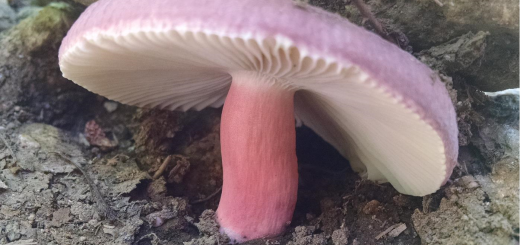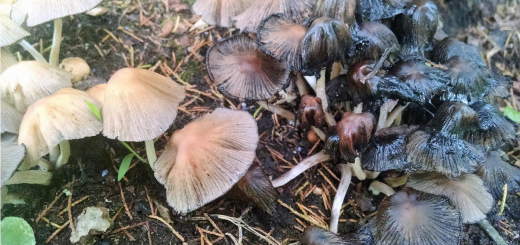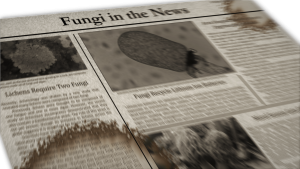#074: Arbuscular Mycorrhizae
Arbuscular mycorrhizae (AM) are the most abundant type of mycorrhizae on earth. In AM, fungi from the phylum Glomeromycota (FFF#015) penetrate plant root cells and grow arbuscules (tree-shaped structures designed to facilitate nutrient exchange).
It is estimated that around 80-90% of plant species form arbuscular mycorrhizae, but these went largely unobserved until the 20th century. The largest structures formed by AM fungi are only a few millimeters across and are found buried in the soil, so it was nearly impossible to find evidence of these fungi for a long time. Consequently, AMs were considered rare until fairly recently. There are fewer than 200 described species of AM fungi, but this low number is likely due in part to their elusive nature. On the other hand, many of the known species have been shown to have a global distribution. Some AM fungi have adapted to specific environments, but most are generalists. This would suggest a fairly low number of AM fungal species, despite millions of years of evolution and an extremely wide distribution. Identification of AM fungal species is based on DNA because these fungi have very few observable features. Differences in cellular morphology can be used to identify Glomeromycota genera, but rarely beyond that.
The life cycle of an AM begins with the germinating spore of a glomeromycotan fungus. After this spore germinates, it must form a mycorrhiza with a plant host. The nascent mycelium has enough stored energy to last for only about a week on its own while actively searching for a host. Once it finds a suitable, nearby root, it forms an infection structure known as an appressorium and penetrates a cell in the root’s epidermis. Hyphae then grow through the cells in the outer layers of the root to reach the cortex. From there, the hyphae branch, spread out, and begin to form mycorrhizal connections. There are two ways that hyphae can spread in the cortex: outside the cells and inside the cells. Some plants have roots with air spaces between cortical cells that run the length of the root. If these are present, the hyphae will grow along them in a linear pattern. In plants without air spaces, the hyphae will move from the interior of one cell directly to the interior of another cell. These hyphae grow in a distinctive coiled pattern.
When a hypha finds a suitable cell, it grows through the cell wall and forms an arbuscule. Arbuscules are highly branched structures that facilitate AM interactions and are so named because they resemble tiny trees. Although the hyphae penetrate the plant’s cell wall, the arbuscules are formed outside of the cell membrane. The plant’s cell membrane is instead pushed in so that it fits around the arbuscule like a glove. Arbuscules are formed by repeated branching into two parts. The hyphae get smaller with each branch, starting at 5-10 micrometers in diameter and ending at less than one micrometer. This creates a large surface area and allows for an efficient exchange of nutrients. Arbuscules begin to collapse after only a couple days, so the fungus must continually form new ones in new cells.
As the fungus grows, it may produce globular cells called vesicles that store energy for the fungus. Because of these structures, arbuscular mycorrhizae were once known as vesicular-arbuscular mycorrhizae (abbreviated to VAM). Since not all glomeromycotan fungi produce vesicles, the name has been shortened to arbuscular mycorrhize. However, the old terms are still frequently used by mycologists. It should be noted that although all AM fungi form arbuscules, arbuscules cannot always be found under the microscope. This is especially true of older sections of roots. While arbuscules are short-lived, vesicles can persist in the root for months or even years. Older sections of roots will therefore feature vesicles and connecting hyphae, but lack arbuscules.
Once the fungus has made an AM connection with a root, it grows an extensive network of hyphae in the soil. These soil hyphae (also known as “extraradicular hyphae”) can be broken up into two different types: absorptive and distributive. Absorptive hyphae are thin, highly branched, and grow in small patches of soil. This shape allows them to efficiently absorb local nutrients. Nutrients in the area around absorptive hyphae are quickly used up, so these hyphae are relatively short-lived. Distributive hyphae are thick and long and make up the bulk of soil hyphae. They serve to connect the absorptive soil hyphae with the root hyphae, thus allowing carbon, nitrogen, phosphorous, etc. to be transported from one part of the fungus to the other. Distributive hyphae will also form new mycorrhizae when they encounter a new root. The process for forming new mycorrhizae is the same as that described above (skipping the spore germination step). Forming new mycorrhizae can potentially create networks that link multiple plants together. Two genera of AM fungi (Scutellospora and Gigaspora) also produce specialized cells known as “auxiliary cells.” These are thin-walled, globular cells that often have spines, knobs, or other small extensions on their surface. It is unclear to me what the purpose of these cells is, but I would guess that it is related to extracting nutrients from the soil.
After the fungus has found a host and has begun extracting nutrients from the soil, it will start to produce spores. Both root hyphae and soil hyphae can produce spores. AM fungi make asexual spores with extremely thick walls. So thick are these protective walls that many of these individual spores can be seen without the aid of a microscope. These spores are usually spherical, but may be slightly teardrop-shaped as a result of how they are attached to the rest of the fungus. Some AM fungi form groups of spores called sporocarps that resemble miniscule truffles. The spores can be found in soil by sieving and then centrifuging the product in a sugar gradient. Having very thick walls allows the spores to survive for long periods of time in adverse conditions. Once the environment returns to normal, the spores germinate and can re-colonize roots. Although spores are formed in the soil or in plant roots, they can be transported from one place to another. Glomeromycotan fungi are not known to form sexual spores or any other reproductive structures. As an aside, germinated spores of AM fungi often look remarkably like Pac-Man.
AMs have not yet lived up to their full potential as a tool to increase crop production. Despite the broad host range and generalist nature of AM fungi, people have found it hard to inoculate individual plants. Another problem is that tilling soil disrupts AM networks and moves AM fungal spores too low in the soil, so the fungi do not re-grow the next year. AMs have been shown to strongly support plant growth while reducing the need for fertilizers and pesticides, but these benefits will remain underutilized until we can come up with a way to reliably inoculate crops on a large scale.
See Further:
http://mycorrhizas.info/vam.html
http://website.nbm-mnb.ca/mycologywebpages/NaturalHistoryOfFungi/Mycorrhizae.html
http://www.botany.hawaii.edu/faculty/wong/BOT135/Lect26.htm
http://www.oeb.harvard.edu/faculty/pringle/pubs/Bever%20et%20al%202001%20BioScience.pdf
http://www.soilquality.org.au/factsheets/arbuscular-mycorrhizas-s-a
http://shachar-hill.plantbiology.msu.edu/?page_id=44
For more on the phylum Glomeromycota, see FFF#015.









![#011: Characteristics of Kingdom Fungi [Archived]](https://www.fungusfactfriday.com/wp-content/themes/hueman/assets/front/img/thumb-small-empty.png)


3 Responses
[…] that plants use AM fungi to communicate with their neighboring plants. For more on AM, see FFF#074. Only one fungus (Geosiphon pyriformis) is known to not form AM. Instead, pyriformis is […]
[…] role. All glomeromycotans form arbuscular mycorrhizas (AM) with various terrestrial plants (see FFF#074 for a full discussion of AM). The one exception to this rule – since there is always an exception […]
[…] are two basic types of mycorrhizas: ectomycorrhizas (see FFF#075) and arbuscular mycorrhizas (see FFF#074). Most plants use arbuscular mycorrhizas and partner with fungi in the Glomeromycota. Those fungi […]